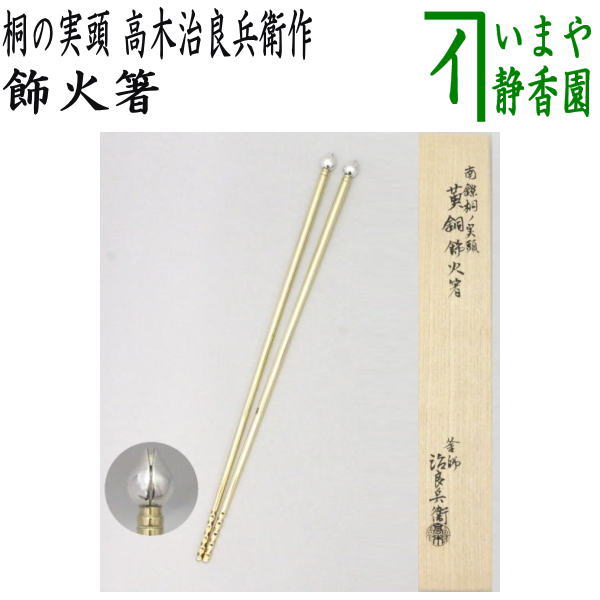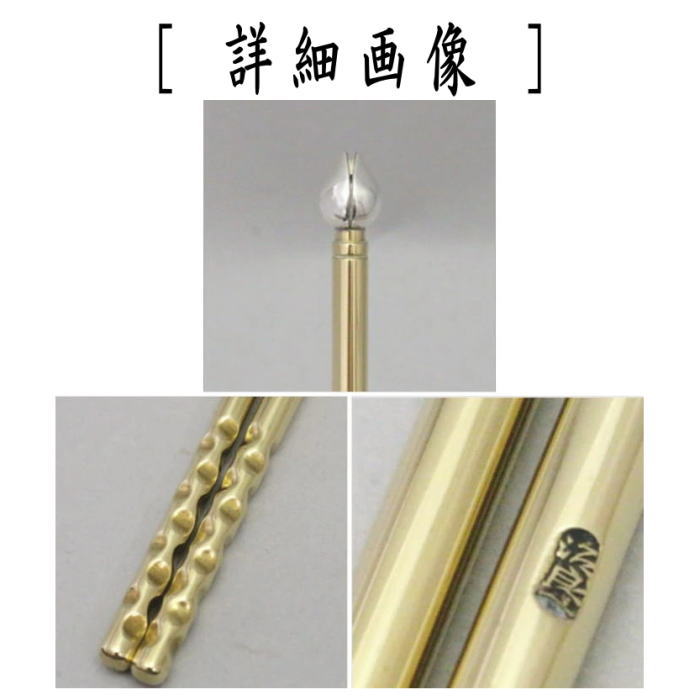NaN
/
of
-Infinity
[Tea utensils/tea ceremony tools, charcoal tools] Decorative fire tongs (decorative fire tongs) Paulownia head, Minami Ryo, brass handle, made by Takagi Jirobei
[Tea utensils/tea ceremony tools, charcoal tools] Decorative fire tongs (decorative fire tongs) Paulownia head, Minami Ryo, brass handle, made by Takagi Jirobei
Product Code: sumitori-157
Regular price
124,667 円
Regular price
Sale price
124,667 円
Unit price
/
per
Tax included.
Shipping calculated at checkout.
Couldn't load pickup availability
●What are hibashi (fire tongs)? Hibashi are metal chopsticks used to put charcoal from a charcoal pot into the brazier or hearth during the sumidemae ceremony, in which the host puts charcoal into the brazier or hearth in front of the guests.
They come in a variety of materials, including sand-plated, brass, and iron, with most being made of iron. There are three types of craftsmanship: hammered, plain (blank or nested), and cast-in. Some also have patterns created using inlay or other techniques.
They are broadly divided into those for furo and those for ro; those for furo are all made of metal, while those for ro have wooden handles; mulberry handles are the most common, and in the Rikyu style, there are also those wrapped in Karaki, black persimmon, and cherry bark.
Fire tongs that are placed next to a ladle in a pedestal or long board ladle stand are called decorative fire tongs, and are always made entirely of metal and are of high rank, with a decoration on the top.
There are also long fire tongs for use in the water room, which are made of iron with a handle wrapped in bamboo skin and secured with hemp thread.
Size: Approx. 29cm in length
Material: Paulownia head (Nanryo)
Handle (Brass)
Author: Written by Jirabei Takagi
----------
Kettle maker and metal craftsman
The origin of the Kamaza dates back to when the capital was moved from Nara to Heian, and metalworkers moved to Kyoto and formed a troupe. Since then, many troupes have declined, but the Kamaza troupe has survived, and the Takagi family still makes kettles and other items, preserving the tradition to this day.
[6th generation] (1943-)
Brother-in-law of the 5th generation master, he inherited and produced the 3rd generation hammer-making technique "Biho", while also studying under the 4th generation master and producing kettles, and working as the guardian of the 5th generation master.
Currently holding many two-person exhibitions around the country
In 2005, the Amida-do kettle and the shoulder kettle were stored at the Kyoto State Guest House.
Currently Director of the Kyoto Metal Crafts Association and Auditor of the Kyoto Metal Crafts Research Association
Since the first generation, research and study has been ongoing
----------
Box: Wooden box
They come in a variety of materials, including sand-plated, brass, and iron, with most being made of iron. There are three types of craftsmanship: hammered, plain (blank or nested), and cast-in. Some also have patterns created using inlay or other techniques.
They are broadly divided into those for furo and those for ro; those for furo are all made of metal, while those for ro have wooden handles; mulberry handles are the most common, and in the Rikyu style, there are also those wrapped in Karaki, black persimmon, and cherry bark.
Fire tongs that are placed next to a ladle in a pedestal or long board ladle stand are called decorative fire tongs, and are always made entirely of metal and are of high rank, with a decoration on the top.
There are also long fire tongs for use in the water room, which are made of iron with a handle wrapped in bamboo skin and secured with hemp thread.
Size: Approx. 29cm in length
Material: Paulownia head (Nanryo)
Handle (Brass)
Author: Written by Jirabei Takagi
----------
Kettle maker and metal craftsman
The origin of the Kamaza dates back to when the capital was moved from Nara to Heian, and metalworkers moved to Kyoto and formed a troupe. Since then, many troupes have declined, but the Kamaza troupe has survived, and the Takagi family still makes kettles and other items, preserving the tradition to this day.
[6th generation] (1943-)
Brother-in-law of the 5th generation master, he inherited and produced the 3rd generation hammer-making technique "Biho", while also studying under the 4th generation master and producing kettles, and working as the guardian of the 5th generation master.
Currently holding many two-person exhibitions around the country
In 2005, the Amida-do kettle and the shoulder kettle were stored at the Kyoto State Guest House.
Currently Director of the Kyoto Metal Crafts Association and Auditor of the Kyoto Metal Crafts Research Association
Since the first generation, research and study has been ongoing
----------
Box: Wooden box
[About paid individual packaging]
If you would like individual packaging (charges apply), click View Cart, check "I would like individual packaging", and then add the desired quantity to "Quantity".
*The following products are not eligible for individual packaging. If you would like to package the folding fan or colored paper, we will provide a paid box or bag for each.
- Mail delivery products
- Folding fan (paid box available/no packaging)
- Colored paper (paid bag available/no packaging)
- Zodiac theme related products
【Related Category】























![[Tea utensils/tea ceremony tools, charcoal tools] Decorative fire tongs (decorative fire tongs) Paulownia head, Minami Ryo, brass handle, made by Takagi Jirobei](http://imaya.co.jp/cdn/shop/products/sumitori-157_5.jpg?v=1709094603&width=1445)
![[Tea utensils/tea ceremony tools, charcoal tools] Decorative fire tongs (decorative fire tongs) Paulownia head, Minami Ryo, brass handle, made by Takagi Jirobei](http://imaya.co.jp/cdn/shop/products/sumitori-157_6.jpg?v=1709094603&width=1445)